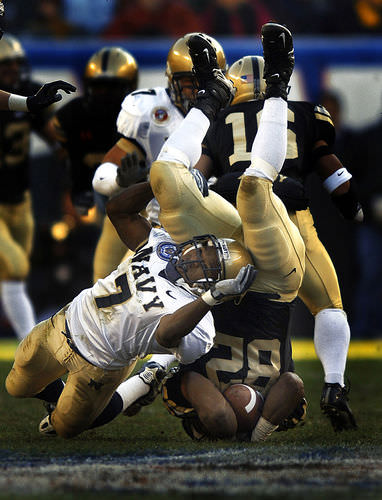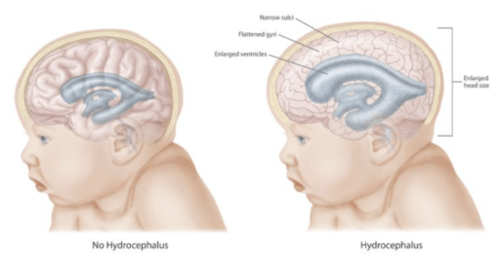9.1 案例研究:了解你的身体
章节大纲
-
Case Study: Under Pressure
::案例研究:压力下Looking at this photo of a football game, you can see why it is so important that the players wear helmets. A s players tackle each other, f ootball often involves forceful impact to the head. This can cause damage to the brain — temporarily (as in the case of a concussion) or long-term and more severe. Helmets are critical in reducing the incidence of traumatic brain injuries (TBIs), but they do not fully prevent them.
::看着足球比赛的照片,你可以看到为什么球员戴头盔如此重要。 当球员相互交锋时,足球往往会给头部造成强烈冲击。 这可能会对大脑造成暂时损害(比如脑震荡 ) , 或长期或更严重的伤害。 盔甲对于减少创伤性脑损伤(TBIs)的发生率至关重要,但并没有完全防止。Take 43-year-old Jason. As a former professional football player who also played in college and high school, Jason sustained many high-impact head injuries over the course of his football playing years. A few years ago, Jason began experiencing a variety of troubling symptoms, including the loss of bladder control (the involuntary leakage of urine), memory loss, and difficulty walking. Symptoms like these are often signs of damage to the nervous system, which includes the brain, spinal cord, and nerves, but they can result from many different types of injuries or diseases that affect the nervous system. In order to treat him properly, Jason’s doctors needed to do several tests to determine the exact cause of his symptoms. The doctors ordered a spinal tap to see if he had an infection, and an MRI (magnetic resonance imaging) to see if there were any observable problems in and around his brain.
::接受43岁的杰森。 作为一名在大学和高中也参加过比赛的前专业足球运动员,杰森在足球比赛期间头部多次受重伤。 几年前,杰森开始经历各种令人不安的症状,包括膀胱控制(非自愿尿液泄漏 ) 、 记忆丧失和行走困难。 类似症状往往是神经系统(包括大脑、脊髓和神经)受损的迹象,但是它们可能来自影响神经系统的多种不同类型的伤害或疾病。 为了正确治疗他,杰森的医生需要做几次测试以确定其症状的确切原因。 医生下令用脊椎抽水看他是否感染了病毒,并用磁共振成像(MRI)检查他的大脑内部和周围是否有明显的问题。The MRI revealed the cause of Jason’s symptoms. There are fluid-filled spaces within the brain called ventricles, and compared to normal ventricles, Jason’s ventricles were enlarged. Based on this observation, along with the results of other tests, Jason’s doctor diagnosed him with hydrocephalus, a term that literally means “water head.” Hydrocephalus occurs when the fluid that fills the ventricles — called cerebrospinal fluid — builds up excessively, causing the ventricles to become enlarged. This puts pressure on the brain, which can cause a variety of neurological symptoms, including the ones Jason was experiencing. I n the illustration , y ou can see the difference between normal ventricles and ventricles that are enlarged due to hydrocephalus. Notice in the image on the right how the brain becomes “squeezed” due to hydrocephalus.
::磁共振反应揭示了杰森症状的原因。 与正常的心血管相比,大脑中存在充斥液体的空间,叫作心室,与正常的心室相比,杰森的心室扩大了。 根据这一观察以及其他测试的结果,杰森的医生诊断他患有脑积水,这个术语实际上意味着“水头 ” 。 当填充脑心室的液体 — — 叫做脑脊椎液 — — 过度积聚,导致心室变大时,脑部就会发生脑部压力,这可能导致各种神经症状,包括杰森正在经历的神经症状。 在图示中,你可以看到正常的心室和因脑积水而膨胀的心室之间的差异。 在图示中,脑部的右侧会注意到脑因脑积水而“窒息 ” 。Comparison of an infant with and without hydrocephalus. The ventricles (shown in blue-gray) are located inside the brain (shown in pink).
::与脑积水和无脑积水的婴儿比较,脑内有(以粉色显示的)心室(蓝灰色显示的),脑内有(以粉色显示的)。Hydrocephalus often occurs at birth, as a result of genetic factors or events that occurred during fetal development. Because babies are born with skull bones that are not fully fused, the skull of a baby born with hydrocephalus can expand and relieve some of the pressure on the brain, as reflected in the enlarged head size shown above. Adults have fully fused, inflexible skulls, so when hydrocephalus occurs in an adult, the brain experiences all of the increased pressure.
::脑积水往往在出生时发生,这是遗传因素或胎儿发育过程中发生的事件造成的,由于婴儿出生时的头骨骨没有完全接合,因此脑脑积水的婴儿头骨可以扩大和减轻脑部的某些压力,如上文显示的脑部大小的扩大所反映,成年人已经完全结合,不灵活头骨,因此当脑积水在成人中发生时,大脑会承受所有增加的压力。Why did Jason develop hydrocephalus? There are many possible causes of hydrocephalus in adults, including tumors, infections, hemorrhages, and TBIs. Given his repeated and long history of football-related TBIs and the absence of any evidence of infection, tumor, or other cause, Jason’s doctor thinks his head injuries were most likely responsible for his hydrocephalus.
::杰森为什么发展了脑积水? 脑积水有多种可能的原因,包括肿瘤、感染、出血和TBI等。 鉴于他与足球有关的TBI史的反复和长期历史以及没有任何感染、肿瘤或其他原因的证据,杰森的医生认为他的头部受伤最有可能是他的脑积水的原因。Although hydrocephalus is serious, there are treatments. Read the rest of this chapter to learn about the cells, tissues, organs, cavities, and systems of the body, how they are interconnected, and the importance of keeping the body in a state of homeostasis (or balance). The amount of cerebrospinal fluid in the ventricles is normally kept at a relatively steady level, and the potentially devastating symptoms of hydrocephalus are an example of what can happen when a system in the body becomes unbalanced. At the end of the chapter, you will learn about Jason’s treatment and prognosis.
::虽然脑积水是严重的,但也有治疗方法。阅读本章的其余部分了解细胞、组织、器官、洞穴和身体系统,它们是如何相互连接的,以及保持身体保持自闭状态(或平衡)的重要性。 脑脊椎中脑脊椎液的数量通常保持在相对稳定的水平上,而脑脑脑积水的潜在破坏性症状是当身体系统失衡时可能发生情况的一个例子。 在本章结尾,你会了解杰森的治疗和预测。Chapter Overview: Introduction to the Human Body
::第一章 概述:人体机构介绍In this chapter, you will learn about the general organization and functions of the human body. Specifically, you will learn about:
::在本章中,你们将了解人体的一般组织和职能。具体地说,你们将了解:-
The organization of the body from atoms and molecules up through cells, tissues, organs, and organ systems
::通过细胞、组织、器官和器官系统从原子和分子向上通过细胞、组织、器官和器官系统将身体组织起来 -
How organ systems work together to carry out the functions of life
::器官系统如何合作履行生命功能 -
The variety of different specialized cell types in humans, the four major types of human tissues, and some of their functions
::人的不同专门细胞种类、四大类人体组织及其部分功能 -
T
he five vital organs and the 11 major organ systems of the human body
::人体的五个重要器官和11个主要器官系统 -
Spaces in the body called body cavities, and the organs they hold and protect
::身体的空间叫做身体洞穴 以及它们拥有并保护的器官 -
The tissues and fluid that protect the brain and spinal cord
::保护大脑和脊髓的组织和液体 -
How organ systems communicate and interact in body processes, such as cellular respiration, digestion, the fight-or-flight response to stressors, and physical activities (such as sports)
::器官系统如何在体体过程,如细胞呼吸、消化、对应应应应应应应应应应应应压力和体力活动(如运动)中进行交流和互动 -
How homeostasis is maintained to keep the body in a relatively steady state, and the problems that can be caused by loss of homeostasis, such as diabetes
::如何保持自足状态,使身体保持相对稳定状态,以及因丧失自足状态可能造成的问题,如糖尿病等。
As you read the chapter, think about the following questions:
::当你读到该章时,请考虑以下问题:1. What is the normal function of cerebrospinal fluid?
::1. 脑脊髓流体的正常功能是什么?2. What is a spinal tap and how does it test for infection?
::2. 什么是脊柱水龙头,如何检测感染?3. In Jason’s case, what organs and organ systems are probably affected by his hydrocephalus? What are some ways in which these organ systems interact?
::3. 就Jason而言,哪些器官和器官系统可能受到其脑积水的影响?这些器官系统有哪些互动方式?4. The level of cerebrospinal fluid is normally kept in a state of homeostasis. What are other examples of types of homeostasis that keep your body functioning properly?
::4. 脑脊髓液水平通常保持在顺势状态下,还有哪些其他类型的顺势体能保持身体正常运转的例子? -
The organization of the body from atoms and molecules up through cells, tissues, organs, and organ systems

